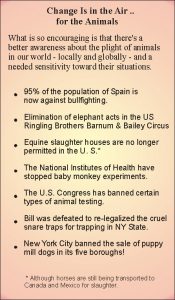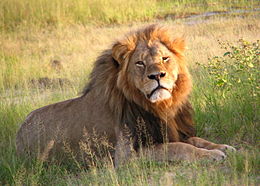Article:
Change Is in the Air
 We are hearing a lot lately about changes in the air. Even though we frequently think of January as a new start, for many people it is September. Summer is unofficially over and we turn our attention to indoor projects and activities.
We are hearing a lot lately about changes in the air. Even though we frequently think of January as a new start, for many people it is September. Summer is unofficially over and we turn our attention to indoor projects and activities.
Thankfully, anyone who works for animal welfare and rights has seen many changes over our lifetime. What is so encouraging is that there’s a better awareness about the plight of animals in our world, both locally and globally, and a much needed sensitivity toward their situations.

There was worldwide outrage over the killing of Cecil, the lion, so popular in Africa that he had a name. Statistics show that 95% of the population of Spain is now against bullfighting. Around the world, there are more and more animal protection organizations forming and seeing positive results.On a national level, big news — long overdue — is the elimination of elephant acts in the Ringling Brothers Barnum and Bailey Circus. Even though there’s a long way to go to alleviate the cruelty inherent in the horse racing industry, there is more knowledge about the dark side of racing. There are no longer equine slaughter houses permitted in the U. S., although the horses are still being transported to Canada and Mexico for slaughter. SeaWorld has seen a drop in attendance and its stock value. The National Institutes of Health have stopped baby monkey experiments and released most of the primates to sanctuaries. Strong legislation banning certain types of animal testing has passed Congress.
In New York, among other victories, a bill passed to require publicly-funded higher education facilities to make retired research animals available for adoption, and a bill was defeated that would have legalized the cruel snare traps for trapping coyotes and other animals. One of the most influential cities in the world, New York, banned the sale of puppy mill dogs in its five boroughs, setting a great educational and humane example.
Locally, many communities have seen judges become increasingly aware of the connection between animal cruelty and domestic violence and who are now willing to mete out harsher sentences. We see more and more on the news about animal cruelty because people are truly enraged about it. In our schools, some humane education programs have been incorporated, and again, NYSHA will be focusing on this crucial need in the coming year.
With all this progress, we still have a very long way to go, and we cannot bask in our successes when there is so much left to be done. The good news is that it can be accomplished when we all share the goal and the task to make sweeping changes for all the animals we share the planet with. After all, it is their world, too!
New York State Humane Association Humane Review, Vol.XXX Fall 2016.